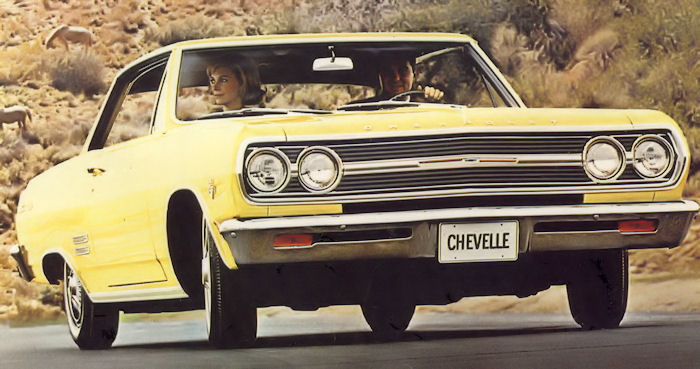Myths About Classic Chevrolet Muscle Cars
Classic Chevrolet muscle cars from the 1960s and 1970s have long held a revered place in the heart of American automotive history. These cars are celebrated for their raw power, iconic design, and cultural significance. However, with such legendary status, a fair share of myths and misconceptions have grown around them. Some are true, but here are ones that are false.

Myth 1: Muscle Cars Were Only About Straight-Line Speed
The Truth: Versatility Beyond the Drag Strip
One of the most enduring myths about muscle cars, including classic Chevrolets, is that they were designed solely for straight-line speed. While it’s true that muscle cars excelled in quarter-mile drag races, many of them were also designed with impressive handling capabilities for their time.
For example, the Chevrolet Camaro Z/28 was equipped with a high-revving 302-cubic-inch V8 engine and handling packages that made it a formidable competitor in the Trans-Am racing series. Similarly, the Chevrolet Corvette, particularly the Stingray models, was renowned for its balanced performance, offering both speed and agility on road courses.
These cars were designed to provide an exhilarating driving experience that went beyond just acceleration. They offered a combination of speed, handling, and braking that made them well-rounded performance machines.
Myth 2: All Classic Chevrolet Muscle Cars Were Gas Guzzlers
The Truth: Variability in Fuel Efficiency
Another common misconception is that all classic Chevrolet muscle cars were notorious gas guzzlers. While it’s true that many of these vehicles were equipped with large, powerful V8 engines that consumed significant amounts of fuel, not all of them were excessively thirsty.
For instance, the Chevrolet Nova SS could be ordered with a range of engines, from economical inline-six engines to high-performance V8s. The smaller displacement engines offered a more balanced approach to fuel consumption without sacrificing the muscle car experience entirely.
Moreover, advancements in carburetion and fuel management during the late 1960s and early 1970s helped improve fuel efficiency in some models. Therefore, while fuel economy was not a primary focus for muscle cars, it varied widely depending on the specific engine and setup.
Myth 3: All Chevrolet Muscle Cars Were Expensive and Rare
The Truth: Accessibility and Production Numbers
There is a belief that classic Chevrolet muscle cars were always expensive and rare, making them out of reach for the average enthusiast. While it’s true that some models, like the Chevrolet COPO Camaro or the Yenko Super Camaro, were produced in limited numbers and have become highly valuable collector’s items, many muscle cars were actually quite accessible when they were new.
The Chevrolet Chevelle, for instance, was produced in large numbers and was available in various trims and engine options, ranging from affordable base models to high-performance SS variants. These cars were often priced competitively, making them accessible to a broad range of buyers.
Today, while some models have appreciated significantly in value, others remain relatively affordable, especially those in less pristine condition or with more common engine options. This makes the world of classic Chevrolet muscle cars more accessible than many might think.
Myth 4: Classic Chevrolet Muscle Cars Were Unsafe
The Truth: Relative Safety for Their Time
There’s a prevalent myth that classic muscle cars, including Chevrolet models, were inherently unsafe. This myth often stems from comparisons with modern vehicles, which benefit from decades of advancements in safety technology.
However, for their time, many muscle cars were equipped with safety features that were advanced by the standards of the era. For instance, by the late 1960s, most Chevrolet muscle cars came with front disc brakes, which significantly improved stopping power compared to older drum brakes. Additionally, seat belts became standard equipment in the mid-1960s, enhancing occupant safety.
While they may not meet today’s rigorous safety standards, classic Chevrolet muscle cars were equipped with the best available safety technology of their era and were not necessarily more dangerous than other cars on the road at the time.

Myth 5: All Chevrolet Muscle Cars Were Big and Heavy
The Truth: Variety in Size and Weight
A common stereotype is that all muscle cars were large, heavy vehicles that handled like tanks. While it’s true that some models, such as the Chevrolet Impala SS, were quite large, Chevrolet also produced a range of more compact muscle cars that were lighter and more agile.
The Chevrolet Nova, for example, was a smaller muscle car that offered impressive performance in a more compact and lightweight package. Similarly, the Chevrolet Camaro was designed to compete in the “pony car” category, offering a smaller, more nimble alternative to larger muscle cars.
These smaller muscle cars were often more agile and offered a different driving experience compared to their larger counterparts, demonstrating that muscle cars came in various shapes and sizes.
Myth 6: Classic Chevrolet Muscle Cars Were Only Popular in the U.S.
The Truth: International Appeal and Influence
It’s often assumed that the appeal of classic Chevrolet muscle cars was limited to the United States. However, these vehicles garnered international attention and had a significant influence on car culture around the world.
In countries like Canada, Australia, and the United Kingdom, American muscle cars, including Chevrolets, were highly coveted and often imported by enthusiasts. The powerful engines, distinctive styling, and cultural cachet of these cars transcended borders and inspired automotive enthusiasts globally.
Moreover, the design and performance principles of American muscle cars influenced automotive manufacturers worldwide, leading to the creation of similar high-performance vehicles in other countries.
Myth 7: Classic Chevrolet Muscle Cars Are Hard to Maintain

The Truth: Simplicity and Availability of Parts
Many people believe that classic muscle cars are difficult and expensive to maintain due to their age and perceived rarity of parts. In reality, classic Chevrolet muscle cars are often simpler to work on compared to modern vehicles, thanks to their straightforward mechanical systems and lack of complex electronics.
Additionally, the popularity of these cars has led to a robust aftermarket industry that provides a wide range of parts and components. Whether you need a new carburetor, suspension components, or body panels, parts for classic Chevrolet muscle cars are widely available and reasonably priced.
Moreover, a large community of enthusiasts and experts exists to provide support and advice, making maintenance and restoration more accessible than one might think.
Classic Chevrolet muscle cars are more than just powerful machines; they are cultural icons that have left a mark on automotive history. Whether you’re a seasoned collector or a new enthusiast, understanding the realities behind these myths can enhance your appreciation and enjoyment of classic Chevrolet muscle cars. For any parts you need for your classic Chevrolet muscle car, visit SS396.com or give our friendly techs a call at (203) 235-1200!





